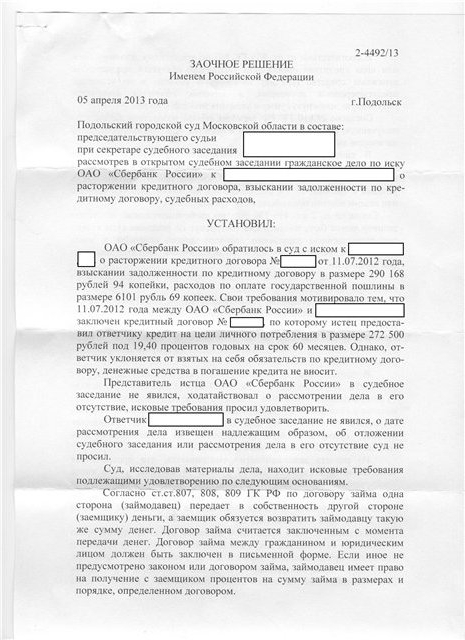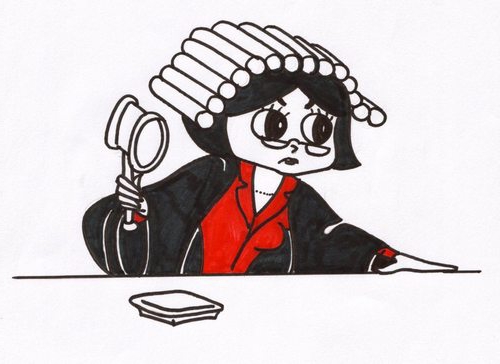Absentee proceedings are instituted if the defendant, delaying the consideration of the dispute, does not want to appear in court. As a result of such proceedings, an appropriate decision is made. In fact, a court decision in absentia, the sample of which generally provides the same elements as the usual one, is beneficial to the plaintiff. In this case, it is possible to resolve the dispute in a shorter time. Next, we will consider this production in more detail - we will find out how the cancellation of the court decision in absentia is carried out. A sample of it will also be considered in the article. 
General information
The description of the procedure of extramural production is contained in chap. 22 GIC. It can be divided into the following stages:
- Adoption of a decision on the possibility of considering the case in the manner prescribed by law.
- The trial.
- Appeal against the decision in absentia.
The content of the resolution, issued as a result of the consideration of the case, must meet the established requirements of the legislation, as well as that adopted in the ordinary procedure of production. General requirements are provided for in Art. 198 GPK.
Document structure
The court decision in absentia includes the following parts:
- Introductory.
- Descriptive.
- Motivational.
- Resolute.
The first part indicates the place and date of the decision, the name of the court, the composition of the court, the secretary, the participants and other parties to the dispute, their representatives, as well as the subject of the proceedings or the requirement. In the descriptive fragment of the document there is an indication of the claim of the plaintiff, objections raised by the defendant, explanations of other persons who are also involved in the dispute. 
Motivation part
It contains characteristics of the circumstances of the case as established by the court. In particular, the evidence is fixed on which the conclusion of the authorized body is based, the arguments according to which the presented argument is rejected by the dispute resolution official. It also indicates the regulations that the court was guided by when making the decision. When the defendant recognizes the claim in the reasoning part, there may be only an indication of this fact and its acceptance by the authorized authority. In case of refusal to consider in connection with the determination of the reasons for missing the statute of limitations or the period during which the appeal to the court is allowed, disrespectful, only the establishment of these circumstances is recorded.
The operative part
In addition to indicating the procedure and time period during which an appeal or cassation appeal can be carried out, there must be a definition of the period and rules for submitting an application for review of the decision by the authority that adopted it. This provision is established in Art. 239 Code of Civil Procedure. As in other decisions, the operative part of the absentee determination contains the consideration of the dispute on the merits. It defines the substantive rights, the obligations assumed by the participants, the procedure for the distribution of production costs. Among other things, the operative part establishes the procedure in accordance with which cancellation of an absentee court decision can be carried out. 
Important point
A reasoned court decision in absentia may be drawn up within five days. In this case, the operative part shall be announced immediately after the end of the proceedings in the same meeting. If the drafting was postponed, the period for sending a copy of the decision is determined by the date of the decision. This requirement is contained in Art. 199 GIC.
Copies of the decision
One of the guarantees ensuring the protection of the rights of the defendant, in the absence of which an absentee court decision is made, is to send him a copy of the decision. The definition is publicly disclosed. The defendant, plaintiff and other parties to the case may familiarize themselves with the content of the decision. Part 2 of Art. 236 of the Code of Civil Procedure contains an order that the court is obliged to send a copy of the decision to the plaintiff, who asked to consider the dispute without it. 
Failure to appear
The absence of the plaintiff, who did not request a hearing without him, does not require the adjournment of the proceedings. In the absence of such a petition, the court may consider the case without the plaintiff notified of the date and place of the hearing, if he did not provide an explanation of the reason for the failure to appear or it was recognized as disrespectful. This provision is contained in Art. 167 Code of Civil Procedure. In the event of a simultaneous failure to appear of the defendant and the plaintiff, who did not ask to consider the case without them, it is possible that a court decision in absentia will be issued. A copy of the decision in this case should be sent to both parties to the dispute within the time period specified in Art. 236 Code of Civil Procedure. Another would be contrary to the existing principle of equality, fixed by Art. 12 GIC. 
Application of general rules: rationale
According to Art. 199 of the Code of Civil Procedure, the formulation of a reasoned decision after ordinary proceedings in a case may be delayed for no more than 5 days. In this case, at the meeting where the hearing ended, the operative part shall be announced. A similar norm establishing the same procedure for a meeting in which an absentee decision is made is missing in Ch. 22 GIC. However, under Art. 234 the adoption of this decision is preceded by a general procedure for conducting proceedings. This, in turn, implies the possibility of postponing the formulation of a motivated absentee decision in accordance with the requirements of Art. 199. Moreover, the stipulated period for sending copies to the defendant and the plaintiff shall be calculated from the date of the final decision.
Third parties
According to Art. 46, 45 and 42 of the Code of Civil Procedure, the plaintiff has the procedural rights of the parties to the proceedings who state independent claims on the subject of the dispute, as well as entities that applied to an authorized court to protect the interests of other persons. In case of non-appearance of these participants, the procedure of art. 236 (part 2) of the Civil Procedure Code for sending a copy of the decision also applies to them. The dispute may be attended by third parties who do not state claims on the subject of the dispute. If they do not appear, they are also sent copies of the decision, but no later than three days from the date of its adoption in final form. 
Legal force of a judgment in absentia
The minimum period during which the decision enters into legal force is 17 days from the date of delivery of the copy to the defendant. After this, the parties to the proceedings, as well as other persons participating in the hearing, and their successors cannot again state the same claims on the same grounds between the same entities. It is also not allowed to challenge legal relations and facts established by a court in another process. An absentee decision has the same legal force as a regular court order. Nevertheless, even with regard to the ruling that entered into force, before the adoption of which the evidence and objections of the defendant were not investigated and established, doubts may arise. Disagreeing parties may challenge the adoption of the decision by writing a statement. 
Cancellation of a court decision in absentia
An application for this is considered at the meeting. The period during which the proceedings of the application is carried out is established by Art. 240 GPK. It is 10 days from the date of receipt of the appeal. As a result of consideration of the application, the authorized instance may adopt a determination that satisfies the requirement contained therein.If there will be a cancellation of the decision in absentia, the court will again initiate proceedings. In this case, the trial is carried out first.
If the defendant was not present at the meeting for valid reasons and did not have the opportunity to report them in time, the court’s absentee decision must be canceled. The sample application is prepared in accordance with the general rules. The appeal shall indicate all the details provided for in such papers, in the descriptive part the defendant gives reasons and evidence of his failure to appear, asks to take them into account and review the case.



